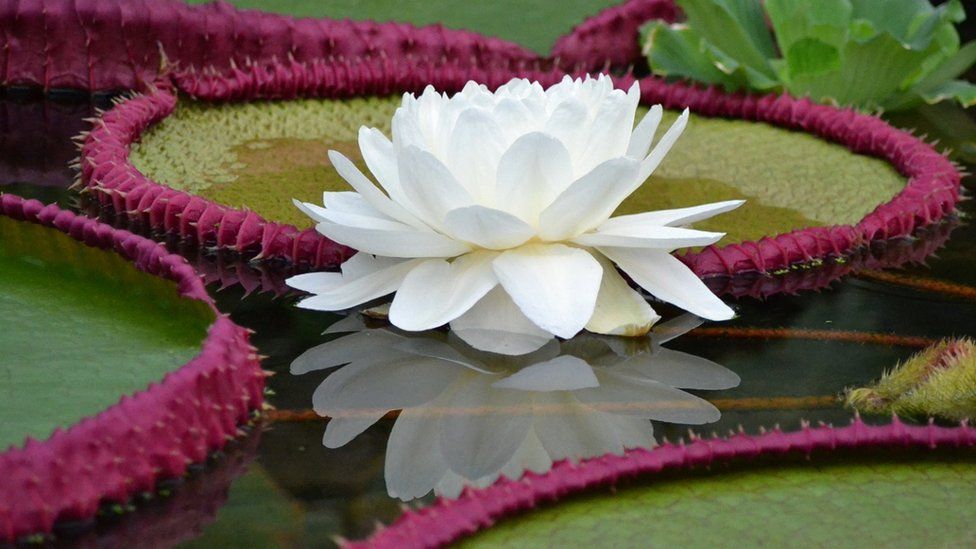ARTICLE AD BOX
 Image source, RGB Kew
Image source, RGB Kew
A species new to science, the world's largest giant waterlily can grow to more than 3m wide
By Claire Marshall
BBC Environment & Rural Affairs Correspondent
Forty-five per cent of the world's known flowering plants could be threatened by extinction, scientists have warned.
Those under threat include orchids, varieties of pineapple, and many important crop species.
Of the nearly 19,000 new plants and fungi species discovered since 2020, 77% are thought to be endangered.
The study by the Royal Botanic Gardens, Kew, examined research by 200 scientists in 30 countries.
Plants underpin every aspect of humanity, said Dr Matilda Brown, conservation specialist at RBG Kew.
But they are increasingly threatened by climate change and biodiversity loss.
"When we consider that nine out of ten of our medicines come from our plants, what we are potentially staring down the barrel at is losing half of all of our future medicines," Dr Brown said.
"Every species we lose is a species that we don't know what opportunities we're losing … It could be a cancer fighting drug, it could be the solution to hunger … And so to lose that, before we get a chance to study it would be a tragedy."
Researchers cross-referenced large data samples from the World Checklist of Vascular Plants, the most comprehensive database of plants currently available, with the International Union for Conservation of Nature's Red List of Threatened Species. They drew up a series of extrapolated predictions about the risk of extinction.
Analysis of the data also suggests there may be 2.5m species of fungi in the world - with 90% yet to be discovered.
There is a backlog of around 100,000 new species of plants found by botanists that are still to be formally classified. The Kew team says these should be automatically described as threatened unless proven otherwise.
Among recent discoveries are the world's largest giant waterlily (Victoriana boliviana) and the Queen's hedgehog mushroom (Hydnum reginae).
Image source, Geoffrey Kibby
Image caption,The Queen's hedgehog, named after the late Queen Elizabeth II, can only be found in Surrey
The report also identified more than 30 global "darkspots" in countries rich in wildlife that botanists haven't yet explored and mapped. Many of these data sinkholes are in tropical Asia, including New Guinea and Vietnam.
Dr Samuel Pironon, from RBG Kew and the UN's Environment Programme World Conservation Monitoring Centre in Cambridge said: "Knowing where there are most species remaining unnamed and unmapped, of which many are likely to be threatened, is crucial. It could help us refine our estimates of priority areas for conservation."
Image source, Irina Petrova Adamatzky
Image caption,The extraordinary properties of fungi are only just being understood
The report calls the fungal kingdom the "next frontier in biodiversity science."
Scientists analysed environmental DNA from soil samples around the world and studied collections using genomics and machine learning. Only 155,000 species of fungi have so far been named.
Fungi's potential is only starting to be understood, for example its ability to consume plastic and its "language" decoded by its electrical signals.
Fungi can do anything, said Kew mycologist Ester Gaya.
"They have amazing compounds, chemicals that can be used for industry, for drug discovery. But we know very little because we only know less than 10% of them. So what happens with the other 90%? There may be amazing resources there that we haven't discovered yet," she said.
'Darwin's dream'
The report draws on the realisation of what it calls "Darwin's dream".
Kew scientists say the World Checklist of Vascular Plants is the most comprehensive plant database ever produced.
It was the result of 35 years of meticulous research by senior Kew botanist Rafael Govaerts.
"More than 160 years ago, Charles Darwin dreamt of a complete list of plant species from every corner of the globe. This has been my dream too, prompted by the rampant destruction of the rainforests and biodiversity in general that I witnessed as a student in the 1980s, and it's exhilarating to see it finally come together," he said.
The list will now constantly evolve, with around 2,500 plants named each year.

 1 year ago
25
1 year ago
25








 English (US) ·
English (US) ·